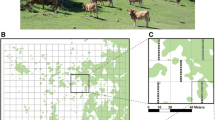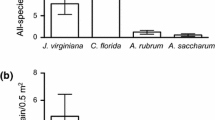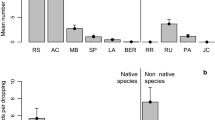Abstract
Although seed dispersal is considered to be a key process determining the spatial structure and spread of non-native plant populations, few studies have explicitly addressed the link between dispersal vector behaviour, seed distribution and seedling recruitment to gain insight into the process of exotic species invasion within a fragmented landscape context. The present study analyses the relationship between avian frugivory and spatial patterns of seed deposition and seedling recruitment for an expanding population of the invasive Prunus serotina in a hedgerow network landscape in Flanders, Belgium. We quantified fruit production, observed frugivores, and determined the spatial distribution of bird droppings and P. serotina seedlings. A relatively diverse assemblage of frugivores visited P. serotina seed trees, with Columba palumbus and Turdus merula being by far the most important dispersers. Landscape structure strongly affected dispersal vector behaviour and the spatial distribution of perching birds, droppings and seedlings. Frugivorous birds non-randomly dispersed seeds to perching sites and an association between perching birds, seed deposition and seedling recruitment was found. Results indicate that landscape structure contributes to non-random seed deposition of P. serotina by common local frugivores. Cutting the larger seed trees is proposed as the most feasible measure to slow down the invasion rate.


Similar content being viewed by others
References
Alcántara JM, Rey PJ, Valera F, Sánchez-Lafuente AM (2000) Factors shaping the seedfall pattern of a bird-dispersed plant. Ecology 81:1937–1950
Bach CE, Kelly D (2004) Effects of forest edges, fruit display size, and fruit colour on bird seed dispersal in a New Zealand mistletoe, Alepis flavida. NZ J Ecol 28:93–103
Bélisle M, Desrochers A (2002) Gap-crossing decisions by forest birds: an empirical basis for parameterizing spatially-explicit, individual-based models. Landsc Ecol 17:219–231
Bollen A, Van Elsacker L, Ganzhorn JU (2004) Tree dispersal strategies in the littoral forest of Sainte Luce (SE-Madagascar). Oecologia 139:604–616
Buckley YM, Anderson S, Catterall CP, Corlett RT, Engel T, Gosper CR, Nathan R, Richardson DM, Setter M, Spiegel O, Vivian-Smith G, Voigt FA, Weir JES, Westcott DA (2006) Management of plant invasions mediated by frugivore interactions. J Appl Ecol 43:848–857
Bullock JM, Moy IL, Pywell RF, Coulson SJ, Nolan AM, Caswell H (2002) Plant dispersal and colonization processes at local and landscape scales. In: Bullock JM, Kenward RE, Hails RS (eds) Dispersal ecology. Blackwell, Oxford, pp 279–302
Clark CJ, Poulsen JR, Connor EF, Parker VT (2004) Fruiting trees as dispersal foci in a semi-deciduous tropical forest. Oecologia 139:66–75
Cordeiro NJ, Patrick DAG, Munisi B, Gupta V (2004) Role of dispersal in the invasion of an exotic tree in an East African submontane forest. J Tropic Ecol 20:449–457
De Langhe JE, Delvosalle L, Duvigneaud J, Lambinon J, Vanden Berghen C (1988) Flora van België, het Groothertogdom Luxemburg, Noord-Frankrijk en de aangrenzende gebieden, 2nd edn. Patrimonium van de Nationale Plantentuin van België, Meise
Deckers B, Hermy M, Muys B (2004) Factors affecting plant species composition of hedgerows: relative importance and hierarchy. Acta Oecol 26:23–37
Deckers B, Verheyen K, Hermy M, Muys B (2005) Effects of landscape structure on the invasive spread of black cherry Prunus serotina in an agricultural landscape in Flanders, Belgium. Ecography 28:99–109
Fowells HA (1965) Silvics of forest trees of the United States. Agriculture Handbook 271. US Department of Agriculture, Forest Service, Washington DC
Galetti M, Alves-Costa CP, Cazetta E (2003) Effects of forest fragmentation, antropogenic edges and fruit colour on the consumption of ornithocoric fruits. Biol Conserv 111:269–273
Galindo-González J, Guevara S, Sosa VJ (2000) Bat- and bird-generated seed rains at isolated trees in pastures in a tropical rainforest. Conserv Biol 14:1693–1703
Gosper CR, Stansbury CD, Vivian-Smith G (2005) Seed dispersal of fleshy-fruited invasive plants by birds: contributing factors and management options. Divers Distrib 11:549–558
Herrera CM (1984) A study of avian frugivores, bird-dispersed plants, and their interaction in Mediterranean scrublands. Ecol Monogr 54:1–23
Herrera CM (1998) Long-term dynamics of Mediterranean frugivorous birds and fleshy fruits: a 12-year study. Ecol Monogr 68:511–538
Herrera CM, Jordano P (1981) Prunus mahaleb and birds: the high-efficiency seed dispersal system of a temperate fruiting tree. Ecol Monogr 51:203–218
Herrera CM, Jordano P, López-Soria L, Amat JA (1994) Recruitment of a mast-fruiting, bird-dispersed tree: bridging frugivore activity and seedling establishment. Ecol Monogr 64:315–344
Holl KD (1998) Do bird perching structures elevate seed rain and seedling establishment in abandoned tropical pasture? Restor Ecol 6:253–261
Hoppes WG (1988) Seedfall pattern of several species of bird-dispersed plants in an Illinois woodland. Ecology 69:320–329
Howe HF, Smallwood J (1982) Ecology of seed dispersal. Ann Rev Ecological Syst 13:201–228
Jordano P (1992) Fruits and frugivory. In: Fenner M (ed) Seeds: the ecology of regeneration in plant communities. CAB International, Wallingford, pp 105–156
Jordano P, Schupp EW (2000) Seed disperser effectiveness: the quantity component and patterns of seed rain for Prunus mahaleb. Ecol Monogr 70:591–615
Krefting LW, Roe EI (1949) The role of some birds and mammals in seed germination. Ecol Monogr 19:269–286
Malo JE, Suarez F (1997) Dispersal mechanism and transcontinental naturalization proneness among Mediterranean herbaceous species. J Biogeogr 24:391–394
McClanahan TR, Wolfe RW (1993) Accelerating forest succession in a fragmented landscape: the role of birds and perches. Conserv Biol 7:279–288
Meyer JY, Florence J (1996) Tahiti’s native flora endangered by the invasion of Miconia calvescens DC (Melastomataceae). J Biogeogr 23:775–781
Muys B, Maddelein D, Lust N (1993) Ecology, practice and policy of black cherry (Prunus serotina Ehrh.) management in Belgium. In: Gjerstad D (ed) Proceedings of the International Conference on Forest Vegetation Management. Ecology, practice and policy. Auburn University, Auburn, pp 86–93
Nathan R, Muller-Landau HC (2000) Spatial patterns of seed dispersal, their determinants and consequences for recruitment. Trends Ecol Evol 15:278–285
Okabe A, Okunuki K, Shiode S (2004) SANET: a toolbox for spatial analysis on a network. Version 2.0. Centre for Spatial Information Science, University of Tokyo, Tokyo
Okabe A, Yamada I (2001) The K-function method on a network and its computational implementation. Geogr Anal 33:271–290
Ortiz-Pulido R, Rico-Gray V (2000) The effect of spatio-temporal variation in understanding the fruit crop size hypothesis. Oikos 91:523–527
Pairon M, Chabrerie O, Casado CM, Jacquemart AL (2006) Sexual regeneration traits linked to black cherry (Prunus serotina Ehrh.) invasiveness. Acta Oecol 30:238–247
Renne IJ, Barrow WC, Randall LAJ, Bridges WC (2002) Generalized avian dispersal syndrome contributes to Chinese tallow tree (Sapium sebiferum, Euphorbiaceae) invasiveness. Divers Distrib 8:285–295
Richardson DM, Allsopp N, D’Antonio CM, Milton SJ, Rejmánek M (2000) Plant invasions - the role of mutualisms. Biol Rev 75:65–93
Ripley BD (1976) The second-order analysis of stationary point processes. J Appl Probab 13:255–266
Russo SE (2003) Responses of dispersal agents to tree and fruit traits in Virola calophylla (Myristicaceae): implications for selection. Oecologia 136:80–87
Schaefer HM, Schmidt V (2002) Feeding strategies and food intake of Blackcaps (Sylvia atricapilla) consuming ripe or unripe fruits and insects. J Ornithol 143:341–350
Schupp EW (1993) Quantity, quality and the effectiveness of seed dispersal by animals. Vegetatio 107/108:15–29
Siegel S, Castellan NJ (1988) Nonparametric statistics for the behavioral sciences. McGraw-Hill, New York
Snow B, Snow D (1988) Birds and berries. A study of an ecological interaction. T & AD Poyser, Calton
Spooner PG, Lunt ID, Okabe A, Shiode S (2004) Spatial analysis of roadside Acacia populations on a road network using the network K-function. Landsc Ecol 19:491–499
Stanley MC, Lill A (2002) Avian fruit consumption and seed dispersal in a temperate Australian woodland. Aust Ecol 27:137–148
Starfinger U (1997) Introduction and naturalisation of Prunus serotina in Central Europe. In: Brock JH, Wade M, Pyšek P, Green D (eds) Plant invasions: studies from North America and Europe. Backhuys Publishers, Leiden, pp 161–171
Toh I, Gillespie M, Lamb D (1999) The role of isolated trees in facilitating tree seedling recruitment at a degraded sub-tropical rainforest site. Restor Ecol 7:288–297
Trakhtenbrot A, Nathan R, Perry G, Richardson DM (2005) The importance of long-distance dispersal in biodiversity conservation. Divers Distrib 11:173–181
Verheyen K, Vanhellemont M, Stock T, Hermy M (2007) Predicting patterns of invasion by black cherry (Prunus serotina Ehrh.) in Flanders (Belgium) and its impact on the forest understorey community. Divers Distrib 13:487–497
Vila M, D’Antonio CM (1998) Fruit choice and seed dispersal of invasive vs. noninvasive Carpobrotus (Aizoaceae) in coastal California. Ecology 79:1053–1060
Wang BC, Smith TB (2002) Closing the seed dispersal loop. Trends Ecol Evol 17:379–385
Wenny DG (2000) Seed dispersal, seed predation and seedling recruitment of a neotropical montane tree. Ecol Monogr 70:331–351
Wenny DG (2001) Advantages of seed dispersal: a re-evaluation of directed dispersal. Evol Ecol Res 3:51–74
Wenny DG, Levey DJ (1998) Directed seed dispersal by bellbirds in a tropical cloud forest. Proc Nat Acad Sci USA 95:6204–6207
Westcott DA, Graham DL (2000) Patterns of movement and seed dispersal of a tropical frugivore. Oecologia 122:249–257
White DW, Stiles EW (1992) Bird dispersal of fruits of species introduced into eastern North America. Can J Bot 70:1689–1696
Williams PA, Karl BJ (1996) Fleshy fruits of indigenous and adventive plants in the diet of birds in forest remnants, Nelson, New Zealand. NZ J Ecol 20:127–145
Acknowledgements
The authors want to express their sincere gratitude to Atsuyuki Okabe and Shino Shiode from the Centre for Spatial Information Science, University of Tokyo, for their kind permission to use the SANET software for Network K-function analysis and providing valuable technical assistance. Besides, the authors would like to thank the two anonymous referees whose comments have substantially improved this paper. The research was supported financially by a Research Assistant Grant of the Fund for Scientific Research, Flanders (FWO) to Bart Deckers. Margot Vanhellemont holds a scholarship from the Research Foundation – Flanders (FWO).
Author information
Authors and Affiliations
Corresponding author
Rights and permissions
About this article
Cite this article
Deckers, B., Verheyen, K., Vanhellemont, M. et al. Impact of avian frugivores on dispersal and recruitment of the invasive Prunus serotina in an agricultural landscape. Biol Invasions 10, 717–727 (2008). https://doi.org/10.1007/s10530-007-9164-3
Received:
Accepted:
Published:
Issue Date:
DOI: https://doi.org/10.1007/s10530-007-9164-3




